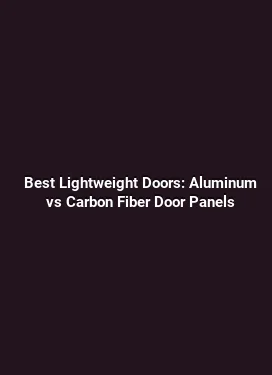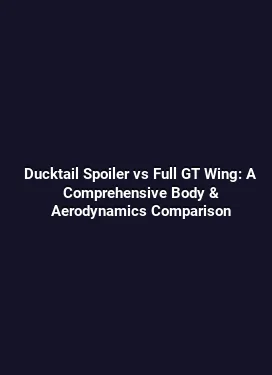How to Install Vortex Generators on Rear Window for Better Airflow
Understanding Vortex Generators and Airflow Dynamics

Vortex generators are small, strategically shaped surfaces placed on a vehicle’s exterior to alter the boundary layer behavior of airflow. When positioned correctly, they generate controlled vortices that energize the flow along the surface, delaying flow separation that typically occurs at the trailing edge of a rear window or hatch. This energizing effect helps reduce turbulent wake, which in turn can lessen drag and improve downforce or stability at higher speeds.
The rear window area presents a unique set of airflow challenges. Depending on the vehicle design, the airflow over the cabin can separate earlier, creating a turbulent wake that increases pressure differentials and disrupts the smooth passage of air toward the tail. Vortex generators oriented along the upper edge or along the sides of the rear window can guide the airstream more effectively. This practice is common on performance-oriented builds and on production vehicles seeking marginal gains in fuel efficiency or handling stability at highway speeds.
Key aerodynamic principles in play

First, boundary layer energization helps keep the flow attached to the glass surface for longer, reducing the size and intensity of wake bubbles behind the vehicle. Second, by shaping the local airflow, these devices can influence the pressure distribution on the rear hatch, which may translate into subtle improvements in stability during crosswinds or at abrupt throttle changes. Finally, the placement of vortex generators matters as much as their geometry; incorrect angles or misaligned spacing can have negligible or even adverse effects.
Rear Window Installation Basics
Before beginning installation, it is essential to perform a measurement and planning phase. Assess the rear window size, curvature, and the surrounding trim to determine feasible mounting points. The goal is to place the devices where the natural airflow interacts with the window edge most effectively, usually around the upper edge of the glass or along the sides where the glass meets the hatch or roofline.
Surface preparation is critical for long-term adhesion and performance. Clean the mounting surface thoroughly with a degreasing solvent and a lint-free cloth. Any residual wax, adhesive residue, or dirt can compromise the bond and lead to premature detachment. For glass surfaces, use a glass-safe cleaner and avoid harsh solvents that could interact with the adhesive used on the vortex generators.
Choosing the right components
Vortex generators come in various shapes, including blade, delta, and clip-on variants. Blade-style units are common for rear applications due to their compact footprint and consistent performance at moderate to high speeds. Delta shapes offer broader influence on the boundary layer but may require careful positioning to avoid glare or visibility concerns. Clip-on options provide a temporary or reversible mounting method, useful for testing before committing to a permanent bond.
Placement Strategies on Different Vehicle Types
Vehicle geometry heavily influences where vortex generators will perform best. Sedans with a relatively flat rear pillar area typically benefit from a row of units along the upper edge of the rear window, spaced evenly to maintain a uniform airflow pattern. Hatchbacks and SUVs with a pronounced roofline may require staggered placement or additional units along the sides to account for the curved transitions.
For sports coupes or high-performance machines, attention to the wind tunnel-inspired details becomes more important. The goal is to reduce the oncoming separation point as the air travels toward the tail, which in turn minimizes wake turbulence. In some cases, a dual-row configuration can be explored, but only after validating that the added devices do not create excessive buffeting or noise at cruising speeds.
Angles and alignment
The angle of each generator relative to the flow is a decisive factor. A common starting point is a shallow angle that tames the boundary layer without introducing abrupt changes to the airflow. Fine-tuning may involve small adjustments in 5- to 10-degree increments and observing the effect on the rear flow during wind-off and wind-on conditions. Consistency across all units is important to avoid asymmetric wake patterns that could destabilize the vehicle at higher speeds.
Mounting Techniques and Materials
Adhesive-backed mounts are widely used for their clean appearance and ease of installation. Automotive-grade double-sided tape with high shear strength is typically selected, supported by a thin bead of compatible silicone sealant to resist moisture ingress. For vehicles with textured or uneven surfaces, a primer or adhesion promoter can improve bond reliability. Mechanical fasteners are less common for rear window applications due to potential damage to glass or trim, but they can be employed in certain off-road or utility contexts with protective gaskets and careful sealing.
Durability is a practical concern. Choose materials that withstand UV exposure, rain, and temperature fluctuations without becoming brittle or discolored. Polycarbonate or reinforced polymer-based generators with a UV-stable coating are common choices. The geometries should resist deformation under typical wind loads encountered at highway speeds and in gusty conditions.
Step-by-step installation workflow
Begin with a mock layout using masking tape to mark each generator position. This helps visualize spacing and symmetry before any adhesive is applied. Measure from fixed reference points such as the C-pillar intersection or the window frame to ensure consistent placement across both sides. Once satisfied, thoroughly clean the surfaces and allow them to dry completely. Apply a light, even pressure during mounting to ensure full contact between the adhesive and the substrate. After installation, cure time is essential; avoid washing the car or exposing it to heavy rain for the recommended period given by the adhesive manufacturer.
Impact on Aerodynamics and Vehicle Handling
Roll- and yaw-induced stability can feel subtly altered when vortex generators are introduced. In many cases, drivers report a calmer wind noise profile at elevated speeds and a more predictable tail-wind response during lane changes on highways. The exact effect depends on vehicle weight distribution, aerodynamics package, and the presence of other add-on elements such as roof racks or spoilers. It is important to manage expectations: gains are often incremental, but when combined with consistent maintenance and careful placement, they can contribute to meaningful improvements in perceived stability and efficiency.
For drivers who pursue precision driving or who operate in variable weather conditions, the added energy in the boundary layer can help maintain a smoother flow around the rear hatch. This translates into more consistent pressure distribution, which may influence gust resilience and reduce the tendency for the rear to feel light when crossing fast-changing wind sectors. Real-world testing with safe, controlled conditions is recommended to validate improvements for a specific vehicle configuration.
Maintenance, Inspection, and Safety
Maintenance involves periodic inspection of all units for signs of detachment, cracks, or discoloration. UV exposure and temperature cycling can degrade adhesives over time, so it is prudent to recheck every 6–12 months, particularly for vehicles frequently exposed to harsh climates or road debris. Cleaning should be gentle; use mild detergents and avoid abrasive cleaners that could scratch the surface or degrade the adhesive bond.
Safety considerations include ensuring that the installation does not obstruct rear visibility or interfere with defrosting elements. Verify that all units remain securely attached after car washes or rough driving conditions. If any unit shows looseness, address it promptly to prevent vibration-induced wear or noise that could develop into a distraction for the driver.
Common Mistakes and Troubleshooting
One of the most frequent mistakes is placing generators too close to the window edge or too far from it, which can minimize their effectiveness or, in worst cases, create adverse flow interactions. Another pitfall is overloading the rear surface with excessive units, which can add unnecessary weight and alter the visual balance of the vehicle. Poor surface preparation is a sure path to premature adhesive failure. Always prioritize a clean, dry mounting area and use compatible bonding agents with explicit heat resistance ratings for outdoor automotive applications.
If vibration or humming is noticed after installation, recheck mounting firmware or adhesive integrity. Sometimes, aerodynamic noise is related to stitching alignment or small gaps around the edge of the generator. In such cases, resealing with proper sealant and re-pressing the units can resolve the issue without requiring full removal.
Case Studies and Practical Scenarios
In a mid-size sedan equipped with a tall rear window, mounting a single row of generators along the upper edge reduced wake intensity at 70–90 mph, yielding a quieter cabin and a slight improvement in perceived stability during crosswinds. A compact SUV with a curved tail benefited from a two-row configuration that followed the geometry of the hatch line, resulting in a more consistent rear airflow pattern across a range of speeds and weather conditions. In both cases, the installations were reversible, and performance observations were primarily qualitative, supported by driver feedback and simple, repeatable checks on vehicle handling at highway speeds.
Advanced Tips and DIY Steps
For enthusiasts exploring a more rigorous approach, start with a controlled test route. Document airspeed, wind angles, and driving stability with and without the devices. Consider creating a simple dashboard checklist to track perceived changes in wind noise, rear-end stability, and any drag-related effects. When selecting materials, favor lightweight composites with high tensile strength and resilience against temperature swings. Compatibility with existing paints and coatings is essential to avoid grey-out or mismatch over time.
When working with warm temperatures, adhesive curing accelerates. Conversely, cooler conditions slow bonding. Plan installation for moderate weather windows and ensure the surface temperature aligns with the adhesive’s operating range. Maintenance routines should include a quick visual check for alignment after long trips or after hitting rough roads to catch any subtle shifts before they become noticeable.
A Practical Checklist Before You Start
To streamline preparation, compile a concise checklist: verify rear window dimensions, choose a compatible generator style, confirm the mounting surface cleanliness, determine the precise spacing pattern, and schedule a test run to observe the impact on airflow. Keep a log of your observations, noting speed ranges, wind conditions, and handling perceptions. This methodical approach helps determine whether the investment yields the desired gains in real-world driving scenarios.






